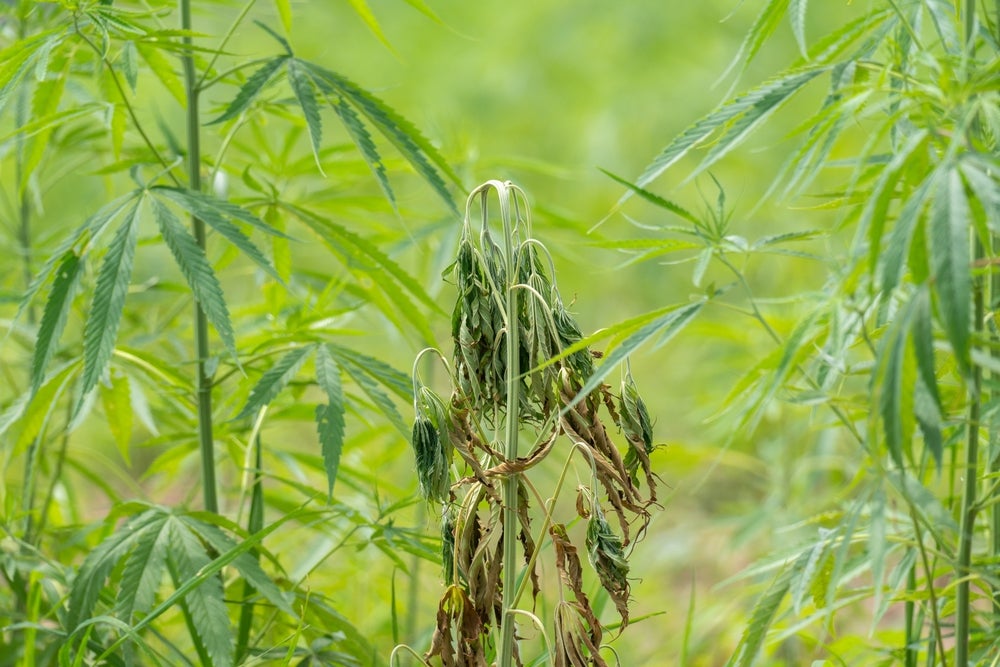Nothing is more heartbreaking for a cannabis cultivator than seeing their healthy crop suddenly afflicted with the telltale signs of Fusarium – wilted, yellowing leaves and dying plants. This notorious fungal pathogen can devastate cannabis gardens, rendering flowers unsalable.
Fusarium proliferates quickly in warm, humid conditions and enters plants through the roots before spreading upwards. Once established, this soil-borne fungus is notoriously difficult to treat. The best approach is prevention by managing environmental factors that allow Fusarium to thrive. But if an infection takes hold, swift action is needed to contain the spread.
In this post, we’ll look at effective strategies for preventing Fusarium and managing infections in both soil and hydroponic cannabis cultivation. With the right techniques, you can sidestep this hazardous fungal foe.
Understanding Fusarium
Fusarium is a genus of fungal mold that includes hundreds of strains. The species Fusarium oxysporum and Fusarium solani commonly infect cannabis plants. Both produce resilient spores that can persist in soil or plant matter for years.
Symptoms usually start with the oldest, lowest leaves turning yellow and wilted. Brown lesions form on stems near soil level. As vascular tissue becomes damaged, younger growth gets stunted. Eventually the entire plant declines.
Left uncontrolled, Fusarium can remain in soil after harvest. The spores infect young cuttings or seedlings planted in the same area during the next grow cycle.
Prevention in Soil Cultivation
Since Fusarium dwells in soil, prevention starts with cultural practices that discourage fungal growth:
Improve soil drainage – Ensure pots have sufficient drainage holes. Use well-draining soil mixes, and avoid compaction.
Let soil dry adequately – Allow the top few inches of soil to dry out between watering. Don’t overwater!
Use sterile media – Disinfect or replace potting mixes between grows.
Mix in compost – Compost increases beneficial microbes that outcompete pathogens.
Solarize soil beds – Cover beds with clear plastic in summer sun for 6-8 weeks to heat-kill fungi.
Use cover crops – Mustard, clover or rye cover crops release antifungal compounds as they decompose.
Rotate crops – Don’t replant cannabis in the same soil two grow cycles in a row.
Control irrigation – Drip irrigation is preferable to sprinklers for directing water to plant bases.
Increase airflow – Improve air circulation near the soil with small fans to discourage fungal growth.
Prevention in Hydroponics
While hydroponics systems don’t use soil, Fusarium can enter through reservoirs and nutrient lines. Here are tips for prevention:
Sterilize equipment – Disinfect system components between grows with hydrogen peroxide or bleach solution.
Use pure water – Filter water with reverse osmosis to remove spores. Change reservoirs frequently.
Avoid system leaks – Fix drips and leaks quickly to prevent pooled moisture.
Keep cool – Maintain water temperature below 70°F (21°C) to slow fungal reproduction.
Check pH – Keep water pH between 5.5 – 6.5, as Fusarium spreads faster in acidic conditions.
Use H2O2 – Add small amounts of hydrogen peroxide to nutrient tanks to suppress microbes.
Monitor roots – Inspect root health often, and promptly remove any dead roots which can host fungi.
Increase airflow – Maximize air circulation via fans around plants and below the canopy.
Treating Fusarium Infections
If Fusarium takes hold despite your best efforts, urgent action is required to save the grow:
Separate infected plants – Isolate and stop handling sick plants to avoid spreading spores.
Remove afflicted plants – Carefully uproot and dispose of badly infested plants in sealed bags. Sterilize the surrounding soil.
Prune infected tissue – Trim off lower dead leaves and stems back to healthy tissue. Sterilize tools between each cut.
Treat with hydrogen peroxide – Water soil or hydro systems with dilute hydrogen peroxide solution to kill fungi.
Use fungicides – Apply registered antifungal agents like Regalia, Actinovate or RootShield according to label instructions. Rotate between types for resistance.
Adjust environment – Increase light intensity, airflow, and temperatures above 75°F to deter Fusarium. Reduce humidity below 40% if possible.
Reduce fertilizer – Excess salts and nitrogen encourage Fusarium, so cut back on nutrients.
Boost microbial life – Introduce beneficial microbes through compost tea, mycorrhizae or inoculants to displace fungi.
Replace growing media – For severe infections, dispose of all soil, hydroton, or water-logged root medium and replace to fully eliminate spore source.
Cleaning Up After Infection
Once the grow cycle concludes, be sure to sanitize the entire cultivation area before the next round. This removes lingering fungal threats:
- Remove all plant debris and root matter
- Discard contaminated growing media
- Wash down all surfaces with hydrogen peroxide or bleach solution
- Replace hydroponic lines, pumps and reservoirs
- Use ozone treatments in sealed rooms to decontaminate air and surfaces
- Soak used pots in diluted bleach, then rinse
Fusarium is a challenging adversary, but proactive prevention and rapid response when infected gives you the upper hand. Stick to resistant strains, sanitize rigorously, and avoid excess humidity. With proper control measures, your garden can flourish free of fungal threats. Stay vigilant, and don’t let this infamous pathogen destroy your hard-earned harvest.
To further expand your knowledge of Cannabis, we invite you to explore our posts on Terpenes: The Hidden Gems in Cannabis Strains, Unveiling The Calming Power of Limonene in Cannabis, and Easy Cannabis Strains for New Growers for comprehensive coverage.
Click here to see list of latest blogs by Mr Clones













